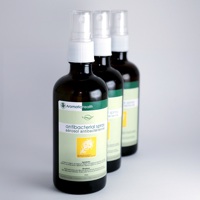Colds and influenza take hold when your immune system’s response is low and your body is weakened. The use of essential oils can aid in the prevention of colds and ‘flu, and help with the symptoms if the infection takes hold. They can also fight secondary infections caused by bacteria. If the symptoms have already developed, essential oils can shorten the duration and help build your immune system. Treating infections without the use of antibiotics will strengthen your immune system. It is important to use essential oils at the first sign of a cold or ‘flu, to prevent the infection.
A few of the essential oils, which have proven effective, include eucalyptus (eucalyptus radiata and globulus), ravensara (ravensara aromatica), peppermint (mentha piperita), tea tree (melaleuca alternifolia), lavender (lavendula alternafolia), (rosemary (rosmarinus officinalis – verbenone type) and thyme (thymus vulgaris). These essential oils have anti-viral, anti-bacterial, decongestant and expectorant properties, to name a few.
For colds and ‘flu, essential oils can be applied topically after dilution in an unscented lotion or carrier oil, through inhalation and absorption in a bath, inhalation on a tissue, or inhalation with a diffuser or humidifier. If applied topically, massage
There are some tactics which can help in staying healthy and avoiding infection, these include staying healthy (by eating properly, getting adequate exercise and sleep), washing hands regularly, eating a lot of garlic, making tea from fresh, shredded ginger root, drinking a lot of water, getting fresh air (especially when enclosed in office space with poor air quality), resting when required and taking supplements such as vitamin C.
Michelle Reynolds, CAHP
1. Antibacterial activity of essential oils and their major constituents against respiratory tract pathogens by gaseous contact. Shigeharu Inouye, Toshio Takizawa, Yamaguchi. Journal of Antimicrobial Chemotherapy.
2. Screening of the antibacterial effects of a variety of essential oils on microorganisms responsible for respiratory infections. Fabio A, Cermelli C, Fabio G, Nicoletti P, Quaglio P. Phytother Res. 2007 Apr;21(4):374-7. PMID: 17326042
3. Essential oils of aromatic plants with antibacterial, antifungal, antiviral, and cytotoxic properties–an overview. Reichling J, Schnitzler P, Suschke U, Saller R. Forsch Komplementmed. 2009 Apr;16(2):79-90. PMID: 19420953
4. In vitro antiviral activity of Melaleuca alternifolia essential oil. Garozzo A, Timpanaro R, Bisignano B, Furneri PM, Bisignano G, Castro A. Lett Appl Microbiol. 2009 Sep 18. PMID: 19843207


